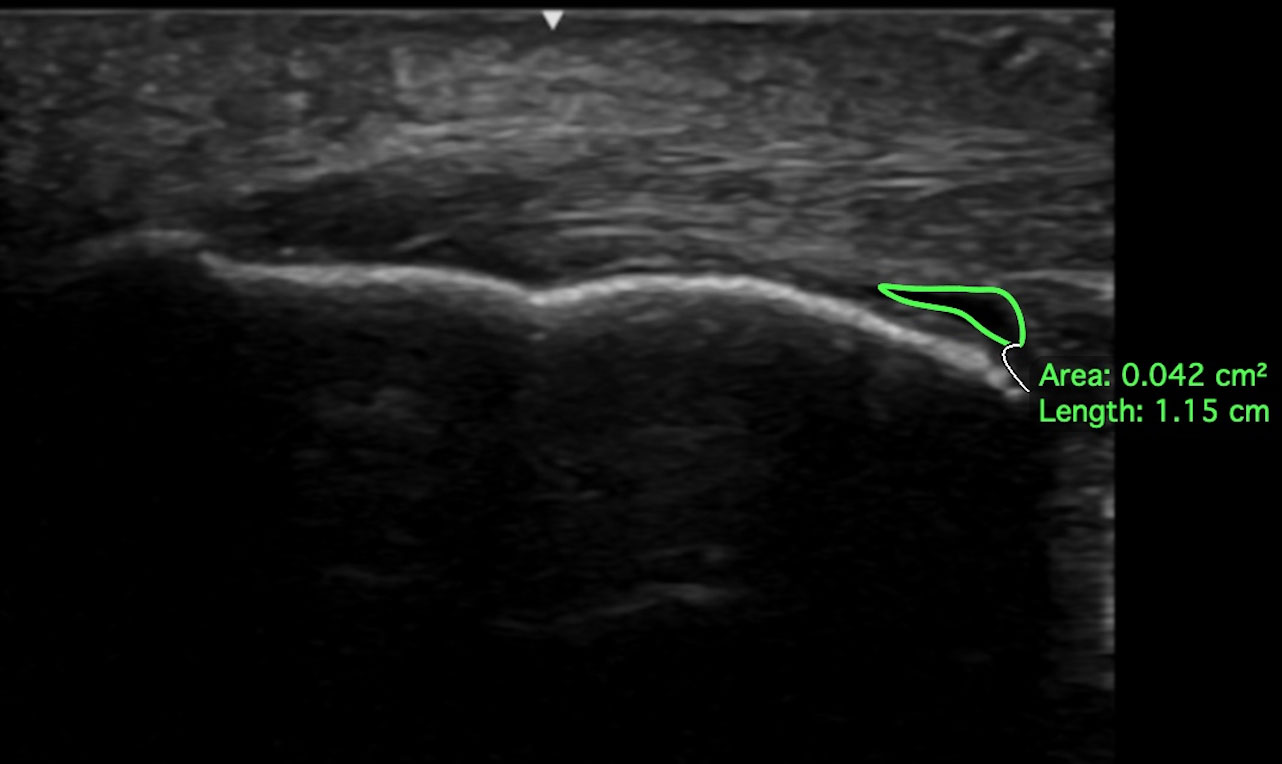Session Information
Session Type: Poster Session B
Session Time: 9:00AM-10:30AM
Background/Purpose: Patients with midportion Achilles tendinopathy who are screened with diagnostic ultrasound may have a collection of anechoic fluid posteroinferior to Kager’s fat pad. A large deposit of fluid accompanied by pain may be referred to as retrocalcaneal bursitis. Retrocalcaneal bursitis that is present with Achilles tendinopathy could be indicative of rheumatoid arthritis. The purpose of this research was to identify the prevalence of retrocalcaneal fluid in patients with midportion Achilles tendinopathy and to explore how fluid area relates to lower extremity function and symptom severity.
Methods: 148 individuals (78 female, mean±standard deviation (SD) age of 48±13 years old and a body mass index (BMI) of 28±6 kg/m2 with midportion Achilles tendinopathy were recruited. The diagnosis was based on pain during palpation and patient-reported physical activity. B-mode ultrasound imaging checked for anechoic fluid collection in the retrocalcaneal area. If the fluid was present, the cross-sectional area (CSA) of the fluid was measured in the sagittal plane. For patients with anechoic fluid, Pearson correlations checked for associations between fluid CSA and measures of lower extremity function and symptom severity. Lower extremity function was assessed using Countermovement Jumping (CMJ), hopping, Drop CMJ, and heel rise endurance. Symptom severity was graded using the Victorian Institute of Sports Assessment-Achilles (VISA-A) questionnaire. Patients rated their pain during palpation and functional testing using the Numeric Pain Rating Scale.
Results: There were 17 participants (11.4% of the sample, 9 female, mean±SD age of 45±12 years old and a body mass index (BMI) of 28±6 kg/m2) who had retrocalcaneal fluid present. The retrocalcaneal fluid area had a mean±SD of 5.2±4.0 mm2 and ranged from 0.2 mm2 to 11.5 mm2. There were moderate associations between fluid area and the following measures: CMJ height (mean±SD 6.5±4.6 cm; r=-0.650, p = 0.005), Drop CMJ height (mean±SD 2.8±2.3 cm; r=-0.583, p = 0.014), heel rise work (mean±SD 1630±1785 Joules; r=-0.508, p = 0.038), and heel rise pain (mean±SD 2.4±2.2; r=0.548, p = 0.023). No associations existed between CMJ pain (mean±SD 1.7±2.2; r=0.270, p = 0.275), DCMJ pain (r=0.328, p = 0.198; mean±SD 3.9±2.5), hopping height (mean±SD 6.3±4.9 cm; r=-0.348, p = 0.186), hopping pain (mean±SD 2.4±2.3; r=0.196, p = 0.430), VISA-A score (mean±SD 49±20 points; r=0.077, p = 0.768), or insertional pain (mean±SD 0.1±0.1; r=-0.132, p = 0.612).
Conclusion: The retrocalcaneal fluid area seems to relate to worse lower extremity function in patients with midportion Achilles tendinopathy. Future research is needed to understand how retrocalcaneal fluid affects recovery.
To cite this abstract in AMA style:
Honick B, Silbernagel K. The Amount of Fluid in the Retrocalcaneal Area Negatively Correlates with Lower Extremity Function [abstract]. Arthritis Rheumatol. 2022; 74 (suppl 9). https://acrabstracts.org/abstract/the-amount-of-fluid-in-the-retrocalcaneal-area-negatively-correlates-with-lower-extremity-function/. Accessed .« Back to ACR Convergence 2022
ACR Meeting Abstracts - https://acrabstracts.org/abstract/the-amount-of-fluid-in-the-retrocalcaneal-area-negatively-correlates-with-lower-extremity-function/

